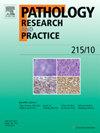A review on tyrosine kinase inhibitors for targeted breast cancer therapy
IF 2.9
4区 医学
Q2 PATHOLOGY
引用次数: 0
Abstract
Breast cancer is a heterogeneous disease with complex molecular pathogenesis. Overexpression of several tyrosine kinase receptors is associated with poor prognosis, therefore, they can be key targets in breast cancer therapy. Tyrosine kinase inhibitors (TKIs) have emerged as leading agents in targeted cancer therapy due to their effectiveness in disrupting key molecular pathways involved in tumor growth. TKIs target various tyrosine kinases, including the human epidermal growth factor receptor 2 (HER2), epidermal growth factor receptor (EGFR), Vascular endothelial growth factor receptor (VEGFR), anaplastic lymphoma kinase (ALK), vascular endothelial growth factor receptor (VEGFR)-associated multi-targets, rearranged during transfection (RET), fibroblast growth factor receptor (FGFR), receptor tyrosine kinase-like orphan signal 1 (ROS1), Mitogen-activated protein kinase (MAPK), and tropomyosin receptor kinase (TRK). These drugs target the tyrosine kinase domain of receptor tyrosine kinases and play a vital role in proliferation and migration of breast cancer cells. Several TKIs, including lapatinib, neratinib, and tucatinib, have been developed and are currently used in clinical settings, often in combination with chemotherapy, endocrine therapy, or other targeted agents. TKIs have demonstrated remarkable benefits in enhancing progression-free and overall survival in patients with breast cancer and have become a standard of care for this population. This review provides an overview of TKIs currently being examined in preclinical studies and clinical trials, especially in combination with drugs approved for breast cancer treatment. TKIs have emerged as a promising therapeutic option for patients with breast cancer and hold potential for treating other breast cancer subtypes. The development of new TKIs and their integration into personalized treatment strategies will continue to shape the future of breast cancer therapy.
酪氨酸激酶抑制剂在乳腺癌靶向治疗中的应用综述
乳腺癌是一种异质性疾病,分子发病机制复杂。多种酪氨酸激酶受体的过度表达与预后不良有关,因此,它们可以成为乳腺癌治疗的关键靶点。酪氨酸激酶抑制剂(TKIs)能有效破坏肿瘤生长的关键分子通路,因此已成为癌症靶向治疗的主要药物。TKIs 针对各种酪氨酸激酶,包括人类表皮生长因子受体 2 (HER2)、表皮生长因子受体 (EGFR)、血管内皮生长因子受体 (VEGFR)、无性淋巴瘤激酶 (ALK)、血管内皮生长因子受体 (EGFR)、血管内皮生长因子受体 (VEGFR)、血管内皮生长因子受体(VEGFR)相关多靶点、转染时重排(RET)、成纤维细胞生长因子受体(FGFR)、受体酪氨酸激酶样孤儿信号 1(ROS1)、丝裂原活化蛋白激酶(MAPK)和肌球蛋白受体激酶(TRK)。这些药物以受体酪氨酸激酶的酪氨酸激酶域为靶点,在乳腺癌细胞的增殖和迁移过程中发挥着重要作用。目前,包括拉帕替尼、奈拉替尼和图卡替尼在内的几种 TKIs 已被开发出来并用于临床,通常与化疗、内分泌治疗或其他靶向药物联合使用。TKIs 在提高乳腺癌患者的无进展生存期和总生存期方面表现出了显著的优势,并已成为这一人群的标准治疗方法。本综述概述了目前正在进行的临床前研究和临床试验中的 TKIs,尤其是与已获批的乳腺癌治疗药物联合使用的情况。TKIs 已成为乳腺癌患者的一种有前途的治疗选择,并具有治疗其他亚型乳腺癌的潜力。新 TKIs 的开发及其与个性化治疗策略的整合将继续塑造乳腺癌治疗的未来。
本文章由计算机程序翻译,如有差异,请以英文原文为准。
求助全文
约1分钟内获得全文
求助全文
来源期刊
CiteScore
5.00
自引率
3.60%
发文量
405
审稿时长
24 days
期刊介绍:
Pathology, Research and Practice provides accessible coverage of the most recent developments across the entire field of pathology: Reviews focus on recent progress in pathology, while Comments look at interesting current problems and at hypotheses for future developments in pathology. Original Papers present novel findings on all aspects of general, anatomic and molecular pathology. Rapid Communications inform readers on preliminary findings that may be relevant for further studies and need to be communicated quickly. Teaching Cases look at new aspects or special diagnostic problems of diseases and at case reports relevant for the pathologist''s practice.

 求助内容:
求助内容: 应助结果提醒方式:
应助结果提醒方式:


